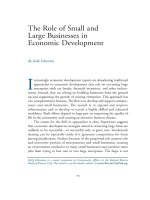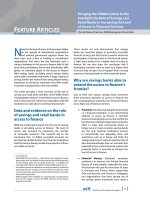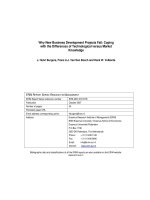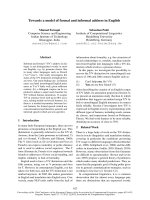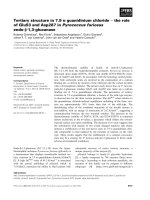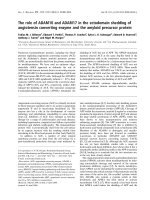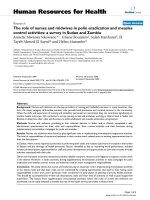Ambidextrous behaviour in new business development projects understanding the role of formal and informal control mechanisms
Bạn đang xem bản rút gọn của tài liệu. Xem và tải ngay bản đầy đủ của tài liệu tại đây (607.11 KB, 87 trang )
AMBIDEXTROUS BEHAVIOUR IN NEW
BUSINESS DEVELOPMENT PROJECTS:
UNDERSTANDING THE ROLE OF FORMAL
AND INFORMAL CONTROL MECHANISMS
Mohammad Mahdi Behrouzi
B.Sc. (Management), M.Sc. (Management)
Supervisors:
Dr. Henri Burgers
Dr. Kavoos Mohannak
Submitted in fulfilment of the requirements for the degree of
Masters of Business
Australian Centre for Entrepreneurship Research School of Management
QUT Business School
Queensland University of Technology
2017
Keywords
Ambidexterity, Exploitation, Exploration, Formal and Informal control mechanisms,
New Business Development Projects.
Ambidextrous behaviour in new business development projects: Understanding the role of formal and
informal control mechanisms
i
Abstract
In recent years, more and more organisations have successfully relied on
ambidextrous
behaviour
to
gain
a
competitive
advantage.
Ambidextrous
organisations simultaneously encourage exploration of new resources through
innovation and creativity and exploitation of current resources by coordinating
resources with organisational strategies.
A recent stream of research has recognised the helpful role control systems
play in making firms more ambidextrous. Most empirical studies in the area of
control systems used to create ambidextrous organisations have been at the corporate
or business-unit level. The literature has paid little attention to the use of control
mechanisms in creating ambidexterity at the new business development project level,
even though they play a central role in today’s managerial exercises.
Taken in this light, the control literature suggests that further research should
examine the role of control systems and their mechanisms in shaping ambidextrous
behaviour in businesses at the project level. The current study aims to fill this gap in
existing strategy and control literature by examining the effect of control
mechanisms on ambidexterity at the new business development project level.
The findings suggest that a complementary relationship between formal and
informal control mechanisms is necessary to successfully develop ambidextrous
behaviour, rather than using the substitutional method. As such, this thesis provides
important insights into the utilisation of control mechanisms in relation to the
development of ambidextrous behaviour in new business development projects. The
findings provide managerial guidance regarding how to carefully combine budget
with interactive control and project manager experience to promote ambidexterity,
and how such a unique combination can function through centralised decisionmaking and interactive control, assisting project members to dynamically interact
using centralised forms of decision-making to develop ambidextrous behaviour.
ii
Ambidextrous behaviour in new business development projects: Understanding the role of formal and
informal control mechanisms
Table of Contents
Keywords..............................................................................................................................i
Abstract ...............................................................................................................................ii
Table of Contents ............................................................................................................... iii
List of Figures ...................................................................................................................... v
List of Tables ......................................................................................................................vi
List of Abbreviations..........................................................................................................vii
Statement of Original Authorship ......................................................................................viii
Acknowledgements .............................................................................................................ix
Chapter 1:
Introduction.................................................................................... 1
1.1
Introduction ............................................................................................................... 1
1.2
Objective of Study...................................................................................................... 3
1.3
Research Questions .................................................................................................... 3
1.4
Contributions ............................................................................................................. 4
1.5
Research Methodology ............................................................................................... 4
1.6
Outline of the Dissertation .......................................................................................... 5
Chapter 2:
Literature Review........................................................................... 7
2.1
Exploitation & Exploration......................................................................................... 7
2.1.1 Conceptual Definition ...................................................................................... 7
2.1.2 Exploration and Exploitation in NBD Projects .................................................. 8
2.2
Ambidexterity .......................................................................................................... 10
2.2.1 Introduction of Ambidexterity ........................................................................ 10
2.2.2 Ambidexterity Definition................................................................................ 11
2.2.3 Organisational Ambidexterity Taxonomy ....................................................... 13
2.2.4 Harmonic Ambidexterity ................................................................................ 15
2.2.5 Balance Ambidexterity vs. Combined Ambidexterity...................................... 16
2.2.6 Ambidexterity Antecedents and Consequences ............................................... 18
2.3
Control Systems ....................................................................................................... 21
2.3.1 Introduction.................................................................................................... 21
2.3.2 Control System Conceptualisation .................................................................. 22
2.3.3 Control Mechanisms: Formal and Informal ..................................................... 22
2.3.4 Combination of Controls mechanisms............................................................. 23
2.3.5 Control Systems and New Business Development Projects ............................. 24
2.3.6 Selected Control Mechanisms ......................................................................... 26
Chapter 3:
Hypothesis Development .............................................................. 29
3.1
Introduction ............................................................................................................. 29
3.2
Combination of Control Mechanisms ....................................................................... 29
3.3
Combination of Interactive Control and Centralised Decision-Making ...................... 31
3.4
Combination of Interactive Control and Budgeting ................................................... 33
Ambidextrous behaviour in new business development projects: Understanding the role of formal and
informal control mechanisms
iii
3.5
Project Manager Experience and Centralised Decision-Making ................................ 34
3.6
Project Manager Experience and Budgeting ............................................................. 35
3.7
Research Model ....................................................................................................... 36
Chapter 4:
Research Methodology ................................................................ 37
4.1
Research Methods .................................................................................................... 37
4.2
Research Setting ...................................................................................................... 38
4.3
Sample and Data Collection ..................................................................................... 38
4.4
Measures ................................................................................................................. 39
4.4.1 Combined Ambidexterity ............................................................................... 40
4.4.2 Centralised Decision-Making ......................................................................... 40
4.4.3 Budgeting ...................................................................................................... 42
4.4.4 Interactive Control ......................................................................................... 43
4.4.5 Project Manager Experience ........................................................................... 43
4.5
Measurement and Validation of Constructs .............................................................. 46
4.5.1 KMO-Bartlett ................................................................................................. 48
4.5.2 Factor Loading ............................................................................................... 48
Chapter 5:
Results .......................................................................................... 49
5.1
Descriptive Statistics and Correlation ....................................................................... 49
5.2
Regression Analysis ................................................................................................. 51
5.3
Interpreting Interaction Effects ................................................................................. 53
Chapter 6:
Discussion and Conclusions ......................................................... 58
6.1
Discussions .............................................................................................................. 58
6.2
Theoretical implication ............................................................................................ 61
6.3
Managerial Implications ........................................................................................... 62
6.4
Limitation and Future Research Direction ................................................................ 63
6.5
Conclusion ............................................................................................................... 65
References ............................................................................................................. 66
iv
Ambidextrous behaviour in new business development projects: Understanding the role of formal and
informal control mechanisms
List of Figures
Figure 2.1 Typology of the formation of organisational ambidexterity .................... 13
Figure 3.1 Research Model ..................................................................................... 36
Figure 5.1: Two-way interaction plot of centralisation and interactive control ......... 54
Figure 5.2: Two-way interaction plot of budget and interactive control ................... 55
Figure 5.3: Two-way interaction plot of centralisation and project manager
experience ................................................................................................. 56
Figure 5.4 Two-way interaction plot of budget and project manager experience ...... 57
Ambidextrous behaviour in new business development projects: Understanding the role of formal and
informal control mechanisms
v
List of Tables
Table 2.1 Organisational Ambidexterity in the Literature........................................ 12
Table 4.1 The operationalisation of the study concept ............................................. 45
Table 5.1: Means, standard deviations, and correlations .......................................... 49
Table 5.2: Multicollinearity .................................................................................... 50
Table 5.3: ANOVAa ............................................................................................... 50
Table 5.4: Results of Regression Analyses for an Ambidexterity ............................ 52
vi
Ambidextrous behaviour in new business development projects: Understanding the role of formal and
informal control mechanisms
List of Abbreviations
NBD
New Business Development
R&D
Research and Development
VIF
Variance Inflation Factors
Ambidextrous behaviour in new business development projects: Understanding the role of formal and
informal control mechanisms
vii
Statement of Original Authorship
The work contained in this thesis has not been previously submitted to meet
requirements for an award at this or any other higher education institution. To the
best of my knowledge and belief, the thesis contains no material previously
published or written by another person except where due reference is made.
Signature:
QUT Verified Signature
Date:
March 2017
viii
Ambidextrous behaviour in new business development projects: Understanding the role of formal and
informal control mechanisms
Acknowledgements
Writing a thesis, especially an academic thesis, is like growing an oak tree.
What kind of acorn will you choose? What soil and fertilizer will you supply? Will
you be able to consistently care for the oak seedling until its roots deepen? It is a
long-term project and requires a “strategy”. I wanted to write the best possible thesis,
that would be beneficial to everyone, especially the business and management
community. Before undertaking my academic study, I ran small businesses in
different industries. As an entrepreneur, I realised that the real “mechanism” of
organisational behaviours and interactions was quite different from what I had read
in prestigious academic publications. Driven by dozens of perplexities and based on
a huge amount of reading, research, and practical investigation, I began the
exploration of my research topic and wrote this thesis.
I wish to acknowledge my sincere thanks and appreciation for my supervisor,
Dr. Henri Burgers, who has been a wonderful role model throughout my research
program studies. Henri has always inspired and taught me at an extremely high
academic standard. I do not remember how many times he revised my thesis and
analysed the data, providing me with generous feedback and comments. A big
thumbs up for all his good-natured patience! Henri is my teacher, my mentor, and
my big brother. I also wish to express my thanks to Dr. Kavoos Mohannak, who
fairly and truly helped me complete this thesis. His generous offer was a tremendous
tonic for my morale.
I would like to profusely thank my parents for their blessings and their faith in
me. I thank them for allowing me to pursue my ambitious dream. I am extremely
grateful for their unwavering encouragement. A big warm hug and great thank you to
my wife, who always stands beside me and supports me tirelessly and
uncomplainingly. Thank you for all your tolerance and patience of my moods during
my writing process.
My thanks also to professional editor, Kylie Morris, who provided copyediting
and proofreading services, according to university-endorsed guidelines and the
Australian Standards for editing research theses.
Ambidextrous behaviour in new business development projects: Understanding the role of formal and
informal control mechanisms
ix
Last but not least, I want to mention that although writing a thesis may be the
most difficult task of your academic life, whatever you choose to study, enjoy. Be
interested, be enthusiastic, it is very rewarding. Don’t forget, one day, the small tiny
acorn will become a mighty soaring oak tree; strong, and beautiful.
x
Ambidextrous behaviour in new business development projects: Understanding the role of formal and
informal control mechanisms
Chapter 1: Introduction
1.1
INTRODUCTION
In today’s highly competitive and dynamic business environment, an
organisation needs to accomplish two conflicting activities to survive. The
organisation needs to constantly optimise its internal operation through exploitation,
while being capable of discovering and exploring new opportunities in the market
(Gibson & Birkinshaw, 2004; O ́Reilly & Tushman, 1996, 2011). The ambidextrous
organisation is capable of managing two contradictory functions: exploitative and
explorative (Lubatkin, Simsek, Ling, & Veiga, 2006). There is tension between these
two functions due to their incompatible features (Andriopoulos & Lewis, 2009;
Raisch, Birkinshaw, Probst, & Tushman, 2009). Such tension can be properly
resolved through suitable utilisation of a control system and its mechanisms, which
will assist the organisation to move toward ambidexterity (Bedford & Malmi, 2015;
Tiwana, 2010).
In this respect, the organisation needs to utilise different control mechanisms to
conduct ambidextrous behaviour, which requires management of the exploitative and
the explorative functions. However, selecting suitable control mechanisms is
challenging, due to the contradictory features and characteristics existing within the
exploitative and explorative functions. The exploitative function is usually
accomplished by using a formal control mechanism (e.g., project efficiency and costreduction), while the explorative function is usually achieved by using an informal
control mechanism (e.g., project innovation and discovery) (Cardinal et al., 2004;
Jansen, Van Den Bosch, & Volberda, 2006; Mundy, 2010; Tiwana, 2010; Ylinen &
Gullkvist, 2013).
Thus, understanding how organisations manage their formal and informal
control mechanisms in order to achieve the ambidextrous behaviour has emerged as
an important research question (Sivabalan & Bisbe, 2015; van der Meer-Kooistra &
Scapens, 2015). Such an understanding demands an investigation into the control
system and its interactive mechanisms in the development of ambidextrous
behaviour (Bedford & Malmi, 2015; Bisbe & Otley, 2004; Mundy, 2010; Sandino,
2007; Kruis, Speklé, & Widener, 2014).
Chapter 1: Introduction
1
Overall, both exploitative and explorative functions need to be managed
through the coexistence of formal and informal mechanisms within the control
system in order to achieve ambidextrous behaviour. However, most studies
examining how control systems are applied in ambidextrous organisations have
primarily focussed on the corporate or business-unit level (Bisbe & Otley, 2004;
Collier, 2005; Henri, 2006; Mundy, 2010; Tuomela, 2005; Widener, 2007). Studies
have paid little attention to the literature regarding the control system and its
interactive mechanisms at the level of new business development (NBD) projects
(Bedford & Malmi, 2015; Sivabalan & Bisbe, 2015). As a result, this conceptual
domain has not been well defined in prior project literature (Chiesa, Frattini,
Lamberti, & Noci, 2010; Jorgensen & Messener, 2009). Little is known about what
type of control mechanism would allow a business to gain ambidexterity at NBD
project levels (Tiwana, 2010). Most importantly, it is explicitly clear how
interactions of formal and informal control mechanisms can benefit a company in
developing ambidextrous behaviour. Disagreement exists about whether the use of
one form of control mechanism reinforces or diminishes the benefits of another
control mechanism in the formation of ambidexterity (Mundy, 2010; Tiwana, 2010).
In other words, do formal and informal control mechanisms complement or
substitute for each other in the development of the ambidextrous project? There is
very little research in this area at the project level (Sivabalan & Bisbe, 2015; Tiwana,
2010). The essential reasoning for studying NBD projects is that in practice such
projects are managed and seen with regards to more explorative purposes, but in
reality consist of both explorative and exploitation activities (Burgers et al., 2008).
This lack of ability to manage and facilitate ambidextrous behaviours in NBD
projects is a major cause of NBD failure (Hill & Birkinshaw, 2014). The
development of supportive organisational mechanisms that nurture ambidextrous
behaviour in new business development is a major gap in the literature (Burgers et
al., 2008; Hill & Birkinshaw, 2014). The primary method for stimulating
ambidextrous behaviour at the organisational level is the combination of informal
and formal control mechanisms (cf. Burgers et al, 2009; Jansen et al., 2009). This
thesis argues that it is therefore important to investigate how these concepts apply to
stimulating ambidextrous behaviour in NBD projects.
2
Chapter 1: Introduction
1.2
OBJECTIVE OF STUDY
The current empirical study seeks to combine two different areas in business
knowledge through the existing communality of strategy and control literature. The
objective of the study is the examination of control systems and their functions in
building ambidextrous behaviour at the project level. The study examines how
interactions of the formal and informal control mechanisms within control systems
can synergistically create ambidextrous behaviour in NBD projects. This
examination could improve understanding of the interactions between control
mechanisms that facilitate a capability for the project members to manage both
exploitative and explorative functions in order to become ambidextrous. The overall
objective of this study is to increase understanding of how organisations can
successfully create ambidextrous new business development projects through the use
of informal and formal control mechanisms.
1.3
RESEARCH QUESTIONS
The current study aims to explain the effects of formal and informal control
mechanisms upon the development of ambidextrous behaviour in new business
development projects. As ambidextrous behaviour is a complex phenomenon,
understanding control systems and interactions of mechanisms can provide a more
comprehensive perspective.
The following research questions address the study’s objective:
1.
What are the relevant formal and informal control mechanisms required to
develop ambidextrous behaviour in new business development projects?
2.
Which type of ambidextrous behaviour is most relevant in the context of
new business development projects?
3.
What are the interaction effects of formal and informal control
mechanisms on ambidextrous behaviour in new business development
projects?
The literature review addresses the first and second questions in this thesis
using theoretical evaluation; while the third question is answered empirically through
the use of the statistical method.
Chapter 1: Introduction
3
1.4
CONTRIBUTIONS
This study contributes to the literature in two ways. Firstly, the current study
draws on prior research in strategic and control literature by investigating formal and
informal mechanisms in relation to organisational ambidexterity. A series of studies
have examined different organisational mechanisms and ambidexterity; for example,
organisational antecedents (Jansen, Volberda, & Van Den Bosch, 2005, 2006),
integration mechanisms (Jansen, Tempelaar, Van den Bosch, & Volberda 2009),
formal and coordination mechanisms (Mom, Van Den Bosch, & Volberda, 2009) and
formal/informal control mechanisms (Bedford, 2015; Tiwana, 2010; Ylinen &
Gullkvist, 2013). This thesis extends the prior studies that have already considered
the combination of organisational mechanisms and their effects on ambidexterity by
adding a new combination of formal and informal control mechanisms. This study
contributes to the literature by expanding how centralised decision-making and
budgeting as formal control mechanisms can benefit the implementation of
ambidextrous behaviour by combining with informal control mechanisms, such as
interactive control and project manager experience.
Secondly, although it is noted that there are interactions affecting the guidance
of ambidexterity and its consequences on different levels (Raisch et al., 2009),
research into organisational ambidexterity usually focuses on the following levels:
individual and unit (Jansen et al., 2006; Mom et al., 2009), top management (Carmeli
& Halevi, 2009; Lubatkin et al., 2006; Nemanich & Vera, 2009), or corporate (Cao
Gedajlovic, & Zhang, , 2009; He & Wong 2004); it largely neglects the project level
(Sivabalan & Bisbe, 2015). This study develops a more comprehensive approach to
NBD. This is addressed by providing evidence of the role of control mechanisms in
building ambidextrous behaviours at the project level. The main contribution of this
study is therefore to explore the role of control mechanisms to manage the competing
theoretical standpoints on whether formal and informal control mechanisms are
complements to, or substitutions for each other in relation to ambidextrous behaviour
at the project level.
1.5
RESEARCH METHODOLOGY
The purpose of this quantitative study is to explore the phenomena of the
effects of formal and informal control mechanisms upon ambidextrous behaviour in
4
Chapter 1: Introduction
NBD projects. The current study employed a cross-sectional survey on NBD in the
Dutch industry. Data collection was undertaken in collaboration with the Association
of Business Development Netherlands, using their database of NBD projects. The
survey was conducted on a sample of 1041 NBD projects. A total of 139 responses
were obtained, with a response rate of 15.1 percent. Moderated regression analysis
was used to analyse the data to investigate the moderation effects of informal control
mechanisms on formal mechanisms in the development of an ambidexterity concept.
1.6
OUTLINE OF THE DISSERTATION
This section provides an overview of the study’s structure and corresponding
research activities.
Chapter 1 - Introduction: This chapter explains the research, outlining the
rationality and objective of the research. The contributions to management
knowledge, as well as its practical implications are also discussed.
Chapter 2 – Literature Review: This chapter begins with an investigation
into the central topic of today’s business market: ambidextrous behaviour. It explains
how such a behaviour is shaped, how control systems can help the formation of
ambidextrous behaviour, and describes the nature of ambidextrous behaviour in NBD
projects. Overall, this chapter aims to synthesise the theoretical concepts of
organisational ambidexterity and control systems in the literature, and explain the
conceptual domain.
Chapter 3 – Hypothesis Development: This chapter develops the hypotheses
in regards to the context of the study and explains the selected control mechanisms
by introducing their features and attributes.
Chapter 4 - Research Methodology: This chapter explains the research
philosophy and provides a justification for the research method and research design
adopted in the proposed hypotheses. A description of the sampling strategy and the
study’s research approach is then provided. Moreover, the chapter explains the
different statistical analytical tools used to determine the research outcomes to
measure and validate the study’s constructs.
Chapter 5 - Results:
Chapter 1: Introduction
5
This chapter provides the regression analysis of the collected data from the
research hypotheses, and interprets the results.
Chapter 6 – Discussion: The final chapter explains the research conclusion by
discussing the empirical findings in the setting of the research hypotheses and
problem statements. The implications of the study and limitations for future research
are then presented.
6
Chapter 1: Introduction
Chapter 2: Literature Review
2.1
EXPLOITATION & EXPLORATION
2.1.1 Conceptual Definition
Exploration and exploitation are the primary organisational activities required
for short-term and long-term survival (March, 1991). Exploration and exploitation
concepts have been commonly investigated in management literature through various
areas, such as organisational learning (Gupta, Smith, & Shalley, 2006; Levinthal &
March, 1993; March, 1991), strategic management (Auh & Menguc, 2008; Ebben &
Johnson, 2005), organisational design and structures (Adler, Goldoftas, & Levine,
1999; Gibson & Birkinshaw, 2004; O‘Reilly & Tushman, 2004), and leadership
(Beckman, 2006; Lubatkin et al., 2006), which stress the substantial and imperative
role of concepts in diverse subjects of managerial science.
In this sense, the literature has presented a diverse set of definitions in regards
to the concepts of exploration and exploitation within different contexts. Therefore,
for a better understanding of the principal meaning, this study demonstrates the
original classifications concerning the context of the current thesis (Bisbe, BatistaFoguet, Chenhall, 2007). In this context, March (1991) and Benner & Tushman’s
(2003) conceptualisations are conducted, respectively, by illustrating the principal
concepts’ clarity, as well as pointing out the concepts’ specification within new
business development (NBD) projects as the context.
The exploitation concept includes such “things as refinement, choice,
production, efficiency, selection, implementation [and] execution”, whereas,
exploration includes “things captured by terms such as search, variation, risk taking,
experimentation, play, flexibility, discovery [and] innovation” (March, 1991, p. 71).
March (1991) emphasised that “the basic problem confronting an organisation is to
engage in sufficient exploitation to ensure its current viability, and at the same time,
devote enough energy for exploration to ensure its future viability” (p. 105).
The current study applies the definitions of Benner and Tushman (2003) who
built upon March (1991) and other scholars within the adaptation literature and
defined the exploitation and exploration concepts as “Incremental technological
Chapter 2: Literature Review
7
innovations and innovations designed to meet the needs of existing customers… and
build upon existing organisational knowledge”.
Exploration is defined as “Radical innovations or those for emergent customers
or markets, they require new knowledge or departures from existing skills” (Benner
& Tushman, 2003, p. 243).
The rationale for using the selected definitions is reflected in the
conceptualisation of the exploitation and exploration concepts in the setting of
radical and incremental innovation. As this study examines the project level of
analysis, it is essential to build new knowledge through radical innovative functions,
while at the same time using and leveraging existing knowledge through incremental
innovative functions (Burgers, Van Den Bosch, & Volberda, 2008). Therefore,
radical and incremental functions must exist in NBD projects. It is also important to
capture features and interrelationships of radical and incremental functions through
the lens of the exploitation and exploration concepts in NBD projects, as their nature
largely depends upon knowledge development (Chiesa et al., 2010).
2.1.2 Exploration and Exploitation in NBD Projects
In recent years, the role of NBD projects has become more attractive to various
organisations that aim to present innovative products and services within their own
inflexible and formalised structures (Burgers et al., 2008). Successful companies
must constantly develop new business opportunities through fresh products and
services; doing so requires developing new technological and market knowledge
through explorative functions, while at the same time applying current knowledge of
their company through exploitative functions (Bauer & Leker, 2013). Therefore,
many companies have operated NBD projects. Firstly, the key aspect of the project’s
structure is managing the knowledge of explorative and exploitative functions
(Burgers et al., 2008). Secondly, most organisational structures and features
primarily concentrate on refining and exploiting products and processes, it is
therefore difficult to explore new business opportunities within those structures.
Taken in this light, at the project-level, explorative and exploitative functions
are explicitly affected by project members, which include multi-actors with a diverse
range of competences and specialties. The timing and extent of the integration
process among project members and explorative and exploitative functions are
8
Chapter 2: Literature Review
highly challenging and crucial. Furthermore, at the project level, the managing of
both functions is affected by both formal (e.g., financing and authorities) and
informal aspects (e.g., the degree of integration and cooperation of the project
manager), which is also highly challenging (Ericsson, 2013; Liu & Leitner, 2012).
In this respect, previous research has mostly studied explorative and
exploitative functions at the firm level (Jansen et al., 2009; O ́Reilly & Tushman,
2011) or business unit level (Gibson & Birkinshaw, 2004; Jansen et al., 2006). Little
attention has been paid to other organisational levels, such as the project level.
Although a few studies have considered explorative and exploitative functions at the
project level by distinguishing between projects to explore new knowledge and
projects for continuous developments of existing knowledge, limited insight has been
uncovered.
In this line of research, for example, Chiesa and colleagues (2010) found that
radical innovation projects, particularly in the early stages of development, are
mainly characterised by a strong support mechanism of informal and social control,
while formal features mostly emerge in the late development and commercialisation
stages. Furthermore, Sivabalan and Bisbe (2015) provided evidence demonstrating
how the formulation of formal with informal mechanisms could have a significant
role in innovation-oriented project work. Their findings show the interactive system
(informal) seeks to identify and adapt new strategies, while the diagnostic system
(formal) is willing to implement existing strategies in the project. The interaction of
interactive and diagnostic systems can help a project tackle both exploitative and
explorative functions. In addition, Andriopoulos and Lewis (2009) examined how the
interplay and interaction of tight coupling (formal) and loose coupling (informal)
mechanisms could significantly assist new product development to manage the
tension between exploitative and explorative functions.
Although recent studies have contributed to this knowledge in some ways
(Andriopoulos & Lewis, 2009; Chiesa et al., 2010; Sivabalan & Bisbe, 2015;
Tiwana, 2008), there is still limited understanding as to how these functions can be
managed in the project-base structure. In this respect, the current literature gap,
which reflects the lack of project studies, is addressed in this thesis through
investigation of how NBD projects can operate explorative and exploitative functions
to build new knowledge and leverage existing knowledge.
Chapter 2: Literature Review
9
2.2
AMBIDEXTERITY
2.2.1 Introduction of Ambidexterity
Ambidexterity is generally defined as a synergetic way of exploiting and
exploring organisational resources that assist the firm in achieving superior
performance. The synergetic method of exploiting and exploring functions requires
accepting a tension between them, each function demanding different features,
competencies, and resources (Jansen et al., 2005). In the context of NBD projects, for
a project to become ambidextrous, the project is required to explore new knowledge
related to new products and services for emerging markets, but also to apply to
current competencies and exploit existing products and services (Danneels, 2002).
Therefore, project members require diverse knowledge, skills, and abilities that
promote both functions. In the setting of an NBD project, exploitative functions are
generally recognised as incremental innovations and short-term performance, while
explorative functions are seen as radical innovations and long-term achievements
(Levinthal & March, 1993; March, 1991). The following section aims to explain the
practical relevance concerning the significant role of ambidexterity and market place.
In the 1980s, the Polaroid Company invested largely in the development of digital
technology, which ultimately provided leading-edge technological competencies in
digital imaging; appropriately, the top manager supported this investment for
capturing larger market shares. At the time, the company was allocating most of its
resources to the exploitation of technological knowledge that essentially enhanced
the company’s ability to achieve the development of digital imaging proficiencies.
Although the company was successful in the exploitation of technological
knowledge, the digital imaging project was not successful. The main reason was that
the Polaroid Company did not recognize the significant need for exploration of new
market knowledge, instead only focusing on exploitation of technological knowledge
and current market knowledge. This reflects the company’s need to simultaneously
pursue both exploitation of current knowledge and exploration of new knowledge as
a means to become ambidextrous. The company at that time had a very successful
experience in instant photography; its business model was a so-called ‘‘razor/blade’’
strategy. This strategy involved the company suddenly dropping the price of cameras
in order to motivate customer demands for film. The company then had a greater
opportunity to sell film and this strategy earned a large amount of money. However,
10
Chapter 2: Literature Review
in the case of digital imaging, where the customers do not use film, the situation
would differ. Thus, requiring the exploration of new market knowledge to understand
the market and competitors. The company had faced many new sets of competitors,
including computer, electronics, and manufacturers companies. On this basis, as the
Polaroid Company largely aligned its resources towards exploiting existing market
knowledge, the company therefore progressively lost its strengths in the digital
imaging and faced failure in capturing the market (Henri et al., 2008) In summary, if
the Polaroid Company had simultaneously focused on both exploitation and
exploration functions, which would have lead the company to act in ambidextrous
manner, it would undoubtedly have become better positioned within the market,
rather than only focusing on one function, such as exploitation. This therefore
reflects why the Polaroid Company failed in its new strategy, as it did not act in an
ambidextrous manner through the simultaneous utilization of exploitative and
explorative functions.
The below section briefly reviews the concept of ambidexterity in the different
conceptual definitions and selects the most appropriate definition based on the
context and nature of the current study.
2.2.2 Ambidexterity Definition
Table 2.1 categorises the conceptual definition of organisational ambidexterity
in management literature from different streams of research.
Chapter 2: Literature Review
11
Table 2.1 Organisational Ambidexterity in the Literature
Stream of research
Conceptual definition
Organisational
“Organisational ambidexterity is the simultaneous pursuit of
learning
exploitation of existing competencies and exploration [of] new
competencies” (March, 1991).
Technological
“The ability to simultaneously pursue both incremental and
innovation
discontinuous innovation and change” (Tushman & O’Reilly,
1996).
Organisational
“Organisational ambidexterity is being aligned and efficient in
adaptation
managing today’s demands, while also being adaptable to changes
in the environment” (He & Wong, 2004).
“Ambidexterity is the ability to both explore new possibilities in
Strategic management
order to cope with future changes in the business environment and
to exploit old certainties to meet today’s business demands” (Mom
et al., 2007).
Organisational design
“The firm ability to design dual structures (mechanistic vs. organic)
that facilitated the initiating and implementation” (Duncan, 1976;
Burn & Stalker, 1961).
Resource perspective
“Organisational ambidexterity is the dynamic capability of an
organisation to simultaneously explore and exploit, accounting for
its ability to adapt” (O’Reilly, Harreld, & Tushman, 2009).
The current study examines the behaviour of organisational ambidexterity,
which can be shaped in NBD projects. More and more organisations are constantly
developing NBD projects, as NBD projects rely heavily on the innovative manner.
NBD projects provide the organisation with the capability to present new products
and services. In this sense, Tushman and O’Reilly (1996) defined ambidexterity as
“the ability to simultaneously pursue both incremental and radical innovation and
change,” which is compatible with the current study. As mentioned previously, NBD
projects rely heavily on knowledge development to provide fresh products and
services; therefore, both incremental and radical innovative functions are essential in
building new knowledge and managing existing knowledge (Chiesa et al., 2010). The
following section reviews the classification of organisational ambidexterity in the
12
Chapter 2: Literature Review
literature and demonstrates how ambidexterity can be shaped through different
approaches.
2.2.3 Organisational Ambidexterity Taxonomy
Researchers have proposed four possible approaches to organisational
ambidexterity pursued between explorative and exploitative activities, which are
systematically classified in the seminal article by Simsek, Heavey, Veiga, & Souder,
(2009). The figure below indicates a typology of the formation of organisational
ambidexterity, which was conceptualised by Simsek and colleagues (2009).
Figure 2.1 Typology of the formation of organisational ambidexterity
Chapter 2: Literature Review
13
